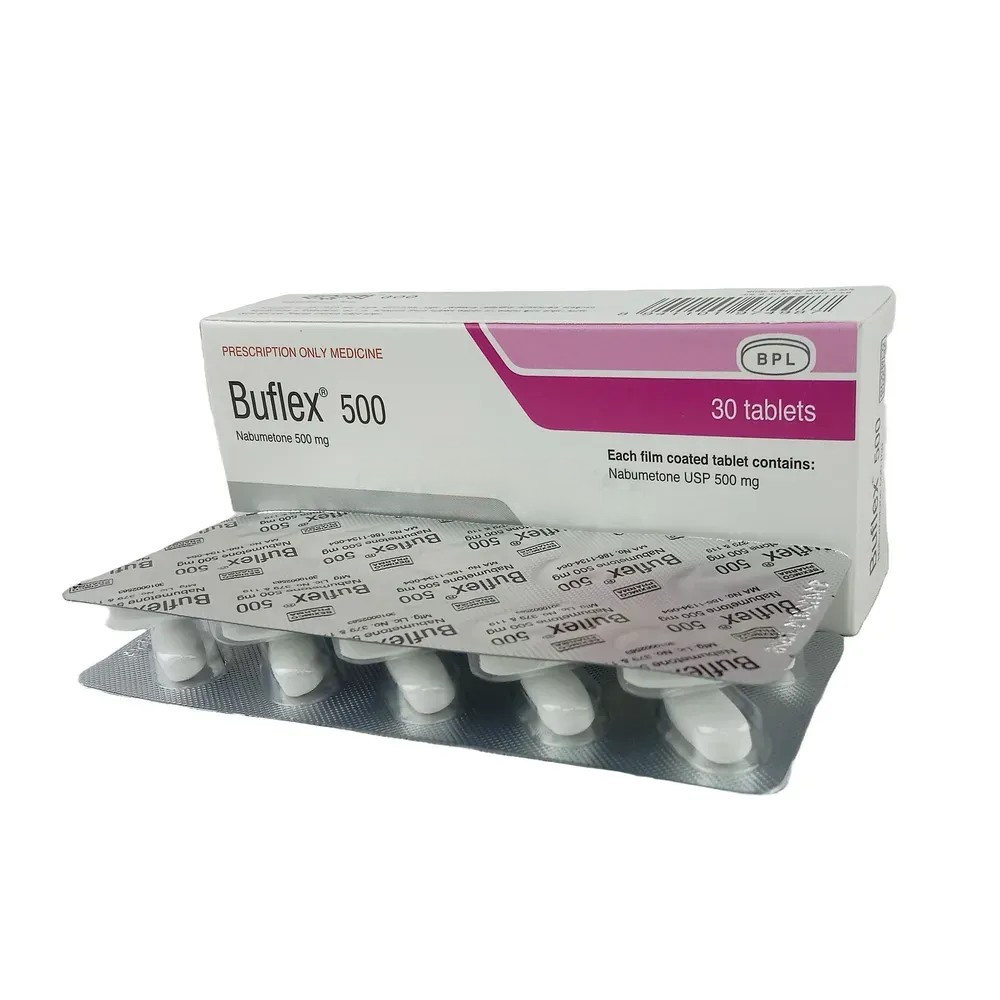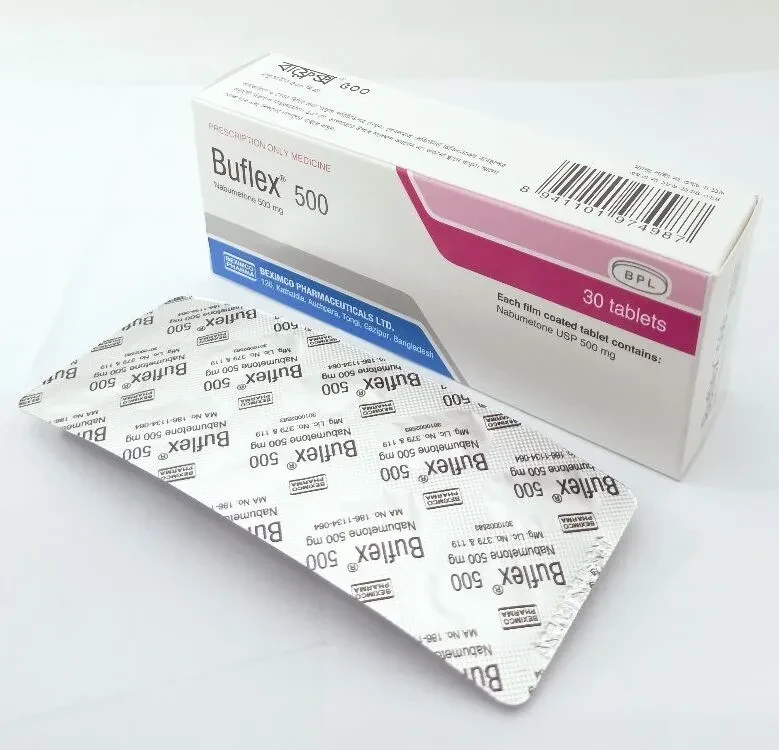Unit Price:
৳ 15.00
(3 x 10: ৳ 450.00)
Strip Price:
৳ 150.00
Also available as:
Indications
Buflex is indicated for relief of signs and symptoms of osteoarthritis and rheumatoid arthritis. Carefully consider the potential benefits and risks of Buflex and other treatment options before deciding to use Buflex. Use the lowest effective dose for the shortest duration consistent with individual patient treatment goals.
Pharmacology
Nabumetone is a non-steroidal anti-inflammatory drug (NSAID) that exhibits anti-inflammatory, analgesic, and antipyretic properties in pharmacologic studies. As with other non-steroidal anti-inflammatory agents its mode of action is not known; however, the ability to inhibit prostaglandin synthesis may be involved in the anti-inflammatory effect. The parent compound is a prodrug. which undergoes hepatic biotransformation to the active component, 6-methoxy-2-naphthylacetic acid (6MNA), that is a potent inhibitor of prostaglandin synthesis
Dosage & Administration
Nabumetone 500 mg & 750 mg Tablet: Oral
Nabumetone 1000 mg Tablet: Mix 1 tablet thoroughly in a glass (250 ml) of pure water and drink it completely.
Osteoarthritis and Rheumatoid Arthritis: The recommended starting dose is 1000 mg taken as a single dose with or without food, Some patients may obtain more symptomatic relief from 1500 mg to 2000 mg per day. Nabumetone can be given in either a single or twice-daily dose. Dosages greater than 2000 mg per day have not been studied The lowest effective dose should be used for chronic treatment.
Moderate or severe renal insufficiency: Caution should be taken in prescribing Nabumetone to patients with moderate or severe renal insufficiency The maximum starting doses of Nabumetone in patients with moderate or severe renal insufficiency should not exceed 750 mg or 500 mg, respectively once daily. Following careful monitoring of renal function in patients with moderate or severe renal insufficiency daily doses may be increased to a maximum of 1500 mg and 1000 mg, respectively.
Use in pediatric patients: Safety and effectiveness in pediatric patients have not been established.
Nabumetone 1000 mg Tablet: Mix 1 tablet thoroughly in a glass (250 ml) of pure water and drink it completely.
Osteoarthritis and Rheumatoid Arthritis: The recommended starting dose is 1000 mg taken as a single dose with or without food, Some patients may obtain more symptomatic relief from 1500 mg to 2000 mg per day. Nabumetone can be given in either a single or twice-daily dose. Dosages greater than 2000 mg per day have not been studied The lowest effective dose should be used for chronic treatment.
Moderate or severe renal insufficiency: Caution should be taken in prescribing Nabumetone to patients with moderate or severe renal insufficiency The maximum starting doses of Nabumetone in patients with moderate or severe renal insufficiency should not exceed 750 mg or 500 mg, respectively once daily. Following careful monitoring of renal function in patients with moderate or severe renal insufficiency daily doses may be increased to a maximum of 1500 mg and 1000 mg, respectively.
Use in pediatric patients: Safety and effectiveness in pediatric patients have not been established.
Interaction
Reports suggest that NSAIDs may diminish the antihypertensive effect of ACE-inhibitors. This interaction should be given consideration in patients taking NSAIDs concomitantly with ACE-inhibitors.
Contraindications
Nabumetone is contraindicated in patients with known hypersensitivity to nabumetone or its excipients. Nabumetone should not be given to patients who have experienced asthma, urticaria, or allergictype reactions after taking aspirin or other NSAIDs. Severe, rarely fatal, anaphylactic-like reactions to NSAIDs have been reported in such patients. Nabumetone is contraindicated for the treatment of peri-operative pain in the setting of coronary artery bypass graft (CABG) surgery
Side Effects
Gastrointestinal: Diarrhea, dyspepsia, abdominal pain, constipation, flatulence, nausea, positive stool guaiac, dry mouth, gastritis, stomatitis, vomiting.
Central Nervous System: Dizziness, headache, fatigue, increased sweating, insomnia, nervousness, somnolence.
Dermatologic: Pruritus, rash
Special Senses: Tinnitus
Miscellaneous: Edema
Central Nervous System: Dizziness, headache, fatigue, increased sweating, insomnia, nervousness, somnolence.
Dermatologic: Pruritus, rash
Special Senses: Tinnitus
Miscellaneous: Edema
Pregnancy & Lactation
Pregnancy Category C. There are no adequate, well-controlled studies in pregnant women. This drug should be used during pregnancy only if dearly needed Because of the known effect of prostaglandin-synthesis-inhibiting drugs on the human fetal cardiovascular system (closure of ductus arteriosus), use of Nabumetone during the third trimester of pregnancy is not recommended Lactation: Nabumetone is not recommended for use in nursing mothers because of the possible adverse effects of prostaglandin-synthesis-inhibiting drugs on neonates
Precautions & Warnings
As a class, NSAIDs have been associated with renal papillary necrosis and other abnormal renal pathology during long-term administration to animals. The second form of renal toxicity often associated with NSAIDs is seen in patients with conditions leading to a reduction in renal blood flow or blood volume, where renal prostaglandins have a supportive role in the maintenance of renal perfusion in these patients, administration of an NSAID results in a dose-dependent decrease in prostaglandin synthesis and, secondarily, in a reduction of renal blood flow, which may precipitate overt renal decompensation Patients at greatest risk of this reaction are those with impaired renal function, heart failure, liver dysfunction, those taking diuretics, and the elderly Discontinuation of NSAID therapy is typically followed by recovery to the pretreatment state
Overdose Effects
Symptoms following acute NSAIDs overdoses are usually limited to lethargy, drowsiness, nausea, and vomiting. and epigastric pain, which is generally reversible with supportive care. Gastrointestinal bleeding can occur. Hypertension, acute renal failure, respiratory depression, and coma may occur but are rare. Anaphylactoid reactions have been reported with therapeutic ingestion of NSAIDs and may occur following an overdose. Patients should be managed by symptomatic and supportive care following a NSAID overdose. There are no specific antidotes. Emesis and/or activated charcoal (60 to 100 grams in adults, 1 to 2 g/kg in children). and/or osmotic cathartic may be indicated in patients seen within 4 hours of ingestion with symptoms or following a large overdose (5 to 10 times the usual dose) Forced diuresis, alkalinization of urine, hemodialysis, or hemoperfusion may not be useful due to high protein binding. There have been overdoses of up to 25 grams of Buflex reported with no long-term sequelae following standard emergency treatment (ie. activated charcoal gastric lavage, IV H2-blockers, etc).
Therapeutic Class
Drugs for Osteoarthritis, Drugs used for Rheumatoid Arthritis
Storage Conditions
Store in a cool and dry place, away from light & moisture. Keep all medicines out of reach of children.
Chemical Structure
| Molecular Formula : | |
| Chemical Structure : | C15H16O2 |
Common Questions about Buflex 500 mg Tablet
What is Buflex 500 mg Tablet?
Buflex 500 mg Tablet is a NSAID that exhibits anti-inflammatory, analgesic, and antipyretic properties.
What is Buflex 500 mg Tablet used for?
Buflex 500 mg Tablet is used for osteoarthritis and rheumatoid arthritis.
Quick Tips
- You have been prescribed Buflex 500 mg Tablet to relieve pain and inflammation.
- Take Buflex 500 mg Tablet with food or milk to prevent upset stomach.
- Take Buflex 500 mg Tablet as per the dose and duration prescribed by your doctor. Long term use may lead to serious complications such as stomach bleeding and kidney problems.
- Buflex 500 mg Tablet may cause dizziness, drowsiness or visual disturbances. Use caution while driving or doing anything that requires concentration.
- Avoid consuming alcohol while taking Buflex 500 mg Tablet as it can cause excessive drowsiness and increase your risk of stomach problems.
- Inform your doctor if you have a history of heart disease or stroke.
- Your doctor may regularly monitor your kidney function, liver function and levels of blood components, if you are taking this medicine for long-term treatment.
Pack Images: Buflex 500 mg Tablet



